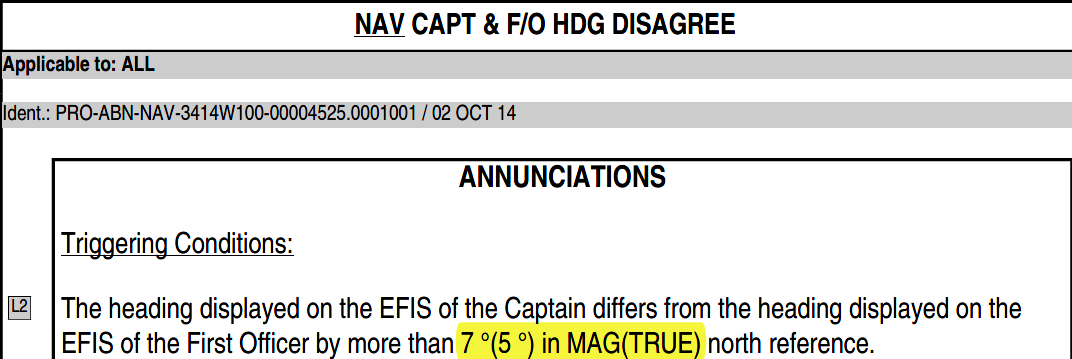NAV CAPT & F/O ATT DISAGREE д»ҘеҸҠ NAV CAPT & F/O HDG DISAGREE иҝҷдёӨдёӘ ECAM иӯҰе‘ҠжҳҜ FWS и§ҰеҸ‘зҡ„пјҢжқЎд»¶жҳҜвҖңдҝҜд»°жҲ–ж»ҡиҪ¬жҳҫзӨәи¶…иҝҮ5В°вҖқвҖңиҲӘеҗ‘жҳҫзӨәи¶…иҝҮ7В°зЈҒиҲӘеҗ‘жҲ–иҖ…5В°зңҹиҲӘеҗ‘вҖқпјҢиҖҢзЁӢеәҸе°ұеҸӘжңүвҖңжңәз»„ж„ҸиҜҶвҖқгҖӮеҜ№жӯӨжңүдёӨзӮ№з–‘й—®пјҡ
- иҝҷдёӘи§ҰеҸ‘еҖјжҳҜеҗҰи¶…иҝҮд»»дҪ• ADIRU иӯҰе‘Ҡзҡ„йҳҲеҖјпјҹ
- жңәз»„жҳҜеҗҰж— йңҖеҒҡд»»дҪ•жЈҖжҹҘпјҢеҰӮеҜ№жҜ” ISISпјҹ
з©әе®ўеӣһеӨҚиҜҙпјҢIR ж•°жҚ®иў« PRIM зӣ‘жҺ§пјҢе№¶дј иҫ“з»ҷ CDS з”ЁдәҺ PFD дёҠзҡ„жҳҫзӨәпјҢиҖҢиҝҷдёӘжҳҫзӨәзҡ„еҶ…е®№еҸҲиў« FWS зӣ‘жҺ§гҖӮFWS и§ҰеҸ‘иӯҰе‘Ҡзҡ„йҳҲеҖјзӯүдәҺжҲ–иҖ…еӨ§дәҺ PRIM жӢ’йҖү IR зҡ„йҳҲеҖјпјҢдёҖиҲ¬жқҘиҜҙпјҢеңЁ FWS иӯҰе‘ҠеҮәзҺ°д№ӢеүҚжҲ–еҗҢж—¶пјҢжңүй—®йўҳзҡ„ IR е°ұиў« PRIM жӢ’йҖүдәҶпјҢд»ҺиҖҢдёӨйғЁ PFD дёҠжҳҫзӨәе·®еҲ«е°ұж¶ҲеӨұдәҶгҖӮжүҖд»ҘпјҢFWS и§ҰеҸ‘зҡ„иӯҰе‘ҠиҰҒд№ҲдёҚдјҡеҮәзҺ°пјҢиҰҒд№ҲеҸӘеҮәзҺ°еҫҲзҹӯзҡ„ж—¶й—ҙгҖӮ然иҖҢпјҢжҹҗдәӣзү№е®ҡжғ…еҶөдјҡеҸӘеҪұе“Қ IR еңЁ PFD дёҠзҡ„жҳҫзӨәж•°жҚ®пјҢжүҖд»Ҙ并дёҚдјҡеҜјиҮҙиў« PRIM жӢ’йҖүпјҢжӯӨж—¶ FWS зҡ„иӯҰе‘Ҡе°ұиғҪеӨҹз»ҷжңәз»„жҸҗдҫӣеҝ…иҰҒзҡ„ж„ҸиҜҶгҖӮ
еңЁ FCOM DSC-34-NAV-20-10-50 A ADIRS MONITORING дёӯпјҢеҜ№жӯӨжңүиҫғиҜҰз»Ҷзҡ„иҜҙжҳҺпјҡ
ADIRSеҸҜд»ҘжҸҗдҫӣж•°жҚ®з»ҷеҫҲеӨҡйЈһжңәзі»з»ҹ: ADIRU, PRIM, FADEC, FWSзӯүгҖӮжҜҸдёӘзі»з»ҹйғҪиғҪзӣ‘жҺ§жүҖжҺҘеҸ—зҡ„ж•°жҚ®пјҢ并иғҪеңЁйңҖиҰҒзҡ„ж—¶еҖҷжӢ’йҖүжҲ–иҖ…йҮҚз”Ёжҹҗдәӣж•°жҚ®гҖӮ
ADIRU зӣ‘жҺ§жҳҜж•°жҚ®жәҗ硬件жң¬иә«пјҢи§ҰеҸ‘зҡ„жҳҜ硬件故йҡңиӯҰе‘Ҡпјҡ
- NAV ADR 1(2)(3) FAULT
- NAV ADR 1+2(1+3)(2+3) FAULT
- NAV ADR 1+2+3 DATA DEGRADED
- NAV ADR 1+2+3 FAULT
- NAV IR 1(2)(3) FAULT
- NAV IR 1+2(1+3)(2+3) FAULT
- NAV IR NOT ALIGNED
- NAV ISIS FCUB BARO REF DISAGREE
PRIM зӣ‘жҺ§зҡ„жҳҜз”ЁдәҺйЈһжҺ§жі•еҲҷи®Ўз®—пјҢд»ҘеҸҠдј иҫ“з»ҷ CDS з”ЁдәҺжҳҫзӨәзҡ„ж•°жҚ®пјҢи§ҰеҸ‘зҡ„жҳҜйЈһжҺ§зӣёе…іиӯҰе‘Ҡпјҡ
- AUTO FLT A/THR OFF
- AUTO FLT AP OFF
- F/CTL DIRECT LAW (PROT LOST)
- NAV AIR DATA REDUNDANCY LOST
- NAV AOA DISAGREE
- NAV ISIS ALT(ATT)(SPD) UNRELIABLE
- NAV ISIS ALT(SPD) RECOVERED
- SURV REACTIVE W/S DET FAULT
з”ЁдәҺйЈһжҺ§и®Ўз®—зҡ„ж•°жҚ®дёҖж—ҰжӢ’йҖүе°ұдёҚеҶҚйҮҚз”ЁпјҢз”ЁдәҺ CDS жҳҫзӨәзҡ„еҲҷеҸҜд»ҘеңЁж•°жҚ®жҒўеӨҚжӯЈеёёеҗҺеҸҜд»ҘйҮҚз”ЁгҖӮCDS жҳҫзӨәйҮҚжһ„йҖ»иҫ‘еҰӮдёӢпјҡ
FADEC зӣ‘жҺ§ ADIRU и®Ўз®—зҡ„ж•°жҚ®пјҢдёҺеҸ‘еҠЁжңәдј ж„ҹеҷЁеҫ—еҲ°зҡ„еҸӮж•°и®Ўз®—еҮәзҡ„ж•°жҚ®еҜ№жҜ”пјҢз”ЁдәҺйҖүжӢ©ж•°жҚ®жәҗгҖӮ
FWS зӣ‘жҺ§е·ҰеҸідёӨдҫ§зҡ„е§ҝжҖҒгҖҒиҲӘеҗ‘гҖҒж°”еҺӢеҹәеҮҶеҸҠж°”еҺӢеҖјзӯүпјҢи¶…иҝҮйҳҲеҖјеҲҷи§ҰеҸ‘иӯҰе‘ҠпјҢз®—жҳҜд»Һз»“жһңдёҠжқҘзӣ‘жҺ§пјҢжҜ”еҰӮпјҡ
- NAV CAPT & F/O ATT DISAGREE
- NAV CAPT & F/O HDG DISAGREE
- NAV GNSS/ACFT POS DISAGREE
- NAV CAPT & F/O BARO VALUE DISAGREE
- NAV CAPT & F/O BARO REF DISAGREE
е…·дҪ“еӣһеӨҚиҜ·еҸӮиҖғ TechRequest еҺҹж–Үпјҡ
Q:
NAV CAPT & F/O ATT DISAGREE
&
NAV CAPT & F/O HDG DISAGREE
Are the threshold of these two alerts triggered by FWS (5 В° in pitch or roll, 7 В°(5 В°) in MAG(TRUE) ) not over the threshold of alerts triggered by ADIRU? And can crew compare the the PFD with ISIS to determine which one is correct?
A:
CAPT AND F/O ATT DISAGREE:
- Initially Pitch slightly increases, when the threshold of 5 DEG is exceeded, Pitch returns to normal again (automatic IR switching), CREW awareness
- On E/WD, NAV RNP AR CAPABILTY DOWNGRADED message is displayed, on DISPATCH page, NAV IR 1(2)(3) REJECTED BY PRIM is displayed,. NO need to cross check Attitudes between PFD/ISIS
CAPT AND F/O HDG DISAGREE (SINGLE MALFUNCTION):
- Initially HDG drifts slowly on PFD, when the threshold 7 DEG in MAG or 5 DEG in TRUE is exceeded HDG returns to normal (automatic IR switching), crew awareness
- On E/WD, AUTO FLT APPROACH CAPABILTY DOWNGRADED and NAV RNP AR CAPABILTY DOWNGRADED message is displayed, NO need to cross check HDG with ISIS and or STDBY Compass
Q_2:
In your answers, once pitch exceeds 5 DEG (HDG exceed 7/5 DEG) wich are the same with triggering threshold of NAV CAPT & F/O ATT DISAGREE & NAV CAPT & F/O HDG DISAGREE, it will return to normal and trigger other alerts. Does that mean these 2 alerts will disappear when parameters return to normal just after triggered? So what are the use of these alerts?
A_2:
IR data are sent to PRIM computers via ARINC 429 buses. The PRIM computers compare these data, and may reject one or more IR sources if they disagree. The monitoring thresholds defined at PRIM level depend on the flight conditions. If an IR source is rejected by PRIM, it will no longer display data on CDS.
IR data displayed on CDS are primarily sent via AFDX network. The FWS compares these data. FWS monitoring thresholds are constant, and are either equal or higher than the PRIM monitoring thresholds.
This means that the IR data monitorings perfomed at PRIM level and FWS level are independent.
In the most probable case of an IR failure leading to general IR data discrepancy, the PRIM monitoring will trigger first, leading to IR source switching. In this case, the FWS monitoring will not trigger, or will trigger for a very short period of time.
However, some specific failure cases may only affect the IR displayed data, without leading to an automatic source switching. In such situation, it is necessary to provide awareness to the crew. This is the aim of NAV CAPT & F/O ATT(HDG) DISAGREE alert.



